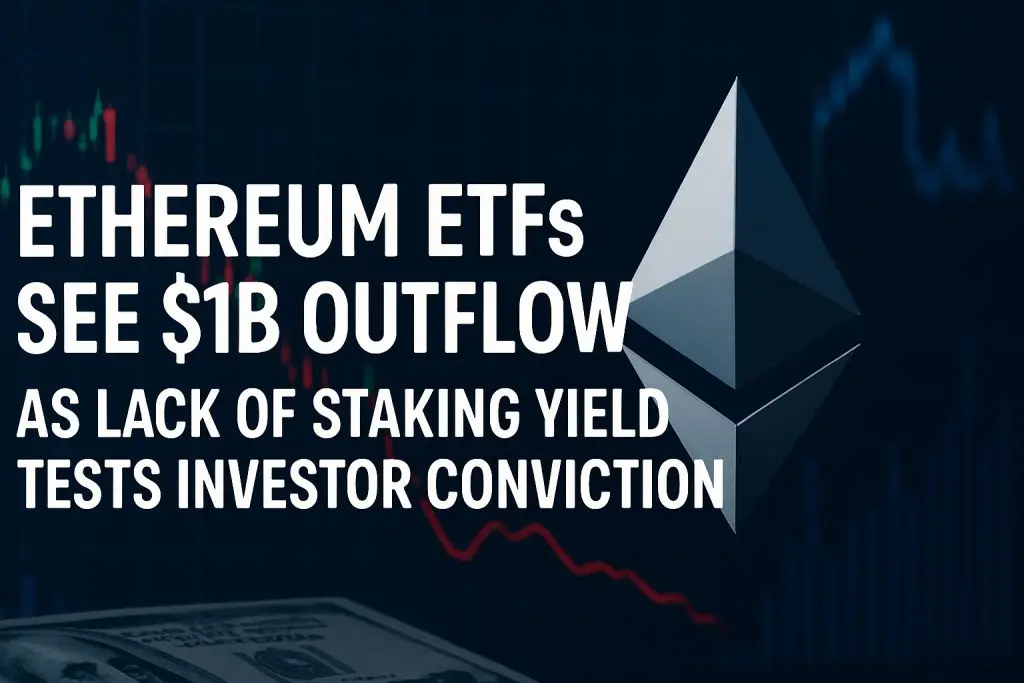After weeks of strong inflows, U.S.-listed Ethereum exchange-traded funds (ETFs) have suddenly reversed course, recording nearly $1 billion in withdrawals over the past week. The sharp turnaround highlights both the fragility of investor confidence and the structural limits of current Ethereum-based financial products.
A Rollercoaster Ride for ETH ETFs
From August 22 to August 28, Ethereum ETFs enjoyed $1.58 billion in inflows, reflecting strong investor demand for regulated ETH exposure. Yet just days later, between August 29 and September 5, they bled roughly $952 million in outflows.
The single-worst day came on September 5, when redemptions spiked to around $446.8 million. For many analysts, this sudden reversal demonstrates that institutional enthusiasm for Ethereum ETFs remains highly reactive to market signals.
The Missing Link: No Staking Yield
Unlike directly holding ETH on-chain, where investors can participate in proof-of-stake validation and earn annual rewards, U.S. Ethereum ETFs cannot stake investor assets.
- BlackRock’s iShares Ethereum Trust (ETHA) explicitly states in its filings that it will neither stake nor provide staking income to investors.
- Other ETF issuers follow the same model, leaving ETF holders with pure price exposure but no yield.
This structural gap matters. With staking yields often above 3% annually, traditional ETF holders may feel disadvantaged, especially when market sentiment weakens. The absence of yield means ETFs provide fewer incentives for investors to “stay put” during drawdowns.
Macro Pressure Meets ETF Volatility
The flows also appear tightly linked to broader economic data. CoinShares’ weekly report (ending September 1) noted that Ethereum ETFs initially attracted $1.4 billion in inflows, but investor behavior flipped after the release of U.S. core Personal Consumption Expenditures (PCE) inflation data.
Why does this matter? PCE is a key inflation gauge used by the Federal Reserve. Any surprise in inflation data can reset expectations for interest rates — which in turn shapes appetite for risk assets like crypto.
When macro signals turn risk-off, Ethereum ETFs seem particularly vulnerable, with outflows magnified by the lack of staking incentives.
Different Issuers, Different Dynamics
Data from Farside Investors shows that not all ETF issuers are impacted equally:
- Grayscale’s ETHE, the oldest and largest ETH product, often faces higher withdrawals on down days.
- Lower-fee funds from competitors like Fidelity and Bitwise tend to gain inflows when sentiment improves, suggesting investors are increasingly sensitive to cost.
This tug-of-war between legacy products and newer, cheaper ETFs contributes to choppy flows and volatility across the sector.
What’s Next for Ethereum ETFs?
Looking forward, three developments could significantly reshape the ETF landscape:
- Macroeconomic conditions – Key inflation releases, interest rate decisions, and broader risk sentiment will continue to dictate short-term ETF flows.
- Regulatory stance on staking – If U.S. regulators eventually permit ETF issuers to stake ETH on behalf of investors, these products could become far more attractive by combining price exposure with yield. (The SEC recently ruled that liquid staking tokens are not securities, a decision that could influence future ETF design — source).
- Competition between issuers – As more players enter the ETF race, differences in fees, redemption policies, and custodial practices will likely determine which funds dominate.
Broader Implications for Ethereum
The ETF rollercoaster also feeds into a larger debate about Ethereum’s place in institutional portfolios. While Bitcoin ETFs remain the flagship for digital asset exposure, Ethereum’s unique utility as a smart contract platform means its growth is not purely speculative.
However, without staking yields integrated into ETF products, Ethereum’s institutional investment case risks being seen as “Bitcoin-lite” — a store-of-value narrative without the added incentives that on-chain ETH holders enjoy.
Quick Snapshot: Ethereum ETF Flow Trends
| Period | Net Flow | Key Factor |
|---|---|---|
| Aug 22 – Aug 28 | +$1.58 billion | Strong inflows, bullish sentiment |
| Aug 29 – Sep 5 | -$952 million | Macro shifts, PCE data, profit-taking |
| Sep 5 (single day) | -$446.8 million | Record daily outflow |
| ETF Structural Weakness | No staking yields | Less incentive to hold long term |
Final Take
The $1 billion pullback in Ethereum ETFs underscores a critical truth: without staking yield integration, investor conviction remains fragile. Until regulators and issuers address this structural shortfall, Ethereum ETFs may continue to experience boom-and-bust flows, heavily influenced by macro headlines and fee competition.
For Ethereum itself, the challenge is clear — bridging the gap between on-chain utility and off-chain financial products. If that balance is ever struck, Ethereum ETFs could evolve from volatile trading tools into long-term institutional staples.
Source: Cryptonews Edited by Sonarx.

